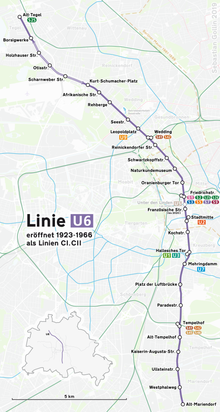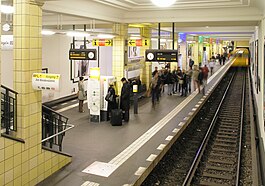
Back U-Bahn-Linie U6 (Berlin) German U6 (Berliin) ET او۶ (متروی برلین) FA U6 (Berliinin metro) Finnish Ligne 6 du métro de Berlin French U6 (הרכבת התחתית של ברלין) HE U6 (Berlin) Croatian Relvia subterran de Berlin/U6 IE Linea U6 (metropolitana di Berlino) Italian ベルリン地下鉄6号線 Japanese


U6 is a 19.9 km (12.4 mi) long rapid transit line on the Berlin U-Bahn with 29 stations. It runs in a north-south direction from the Berlin locality of Tegel in the north via Friedrichstraße to Mariendorf, a locality in the southern part of the city. It is one of the five large profile ("Großprofil") lines.[3]
During the Cold War, both U6 termini were in the former West Berlin but the line passed under East Berlin for a short section of its route. Five of its stations were sealed off by East German authorities and the trains went through these so-called “ghost stations” without stopping, while a sixth, Friedrichstraße, remained open primarily as a transfer station between the U6 and the S-Bahn lines using the north-south S-Bahn tunnel, but also as an official border crossing between East and West Berlin.
It was formerly named "CI" from 1923 to 1928.
- ^ "Einsatz Fahrzeugtypen U-Bahn". Berliner Linienchronik (in German). Berlin: Fabian Sawall. 1 January 2023. Archived from the original (PDF) on 11 June 2023. Retrieved 11 June 2023.
- ^ "Berlin Subway • Trackmap" (PDF). Gleisplanweb.de (in German and English). Kranenburg: Christian Stade. 11 December 2022. Archived from the original (PDF) on 7 April 2023. Retrieved 11 June 2023.
- ^ For historical reasons, the Berlin U-Bahn has cars of two different widths (designated small profile and large profile) despite their common track gauge (similar to the A and B Divisions of the New York City Subway). This necessitates independent operation of the lines on which they travel and a separate servicing infrastructure because of the different tunnel diameters and power supply systems. The narrower cars were built until 1930.
Cite error: There are <ref group=lower-alpha> tags or {{efn}} templates on this page, but the references will not show without a {{reflist|group=lower-alpha}} template or {{notelist}} template (see the help page).
